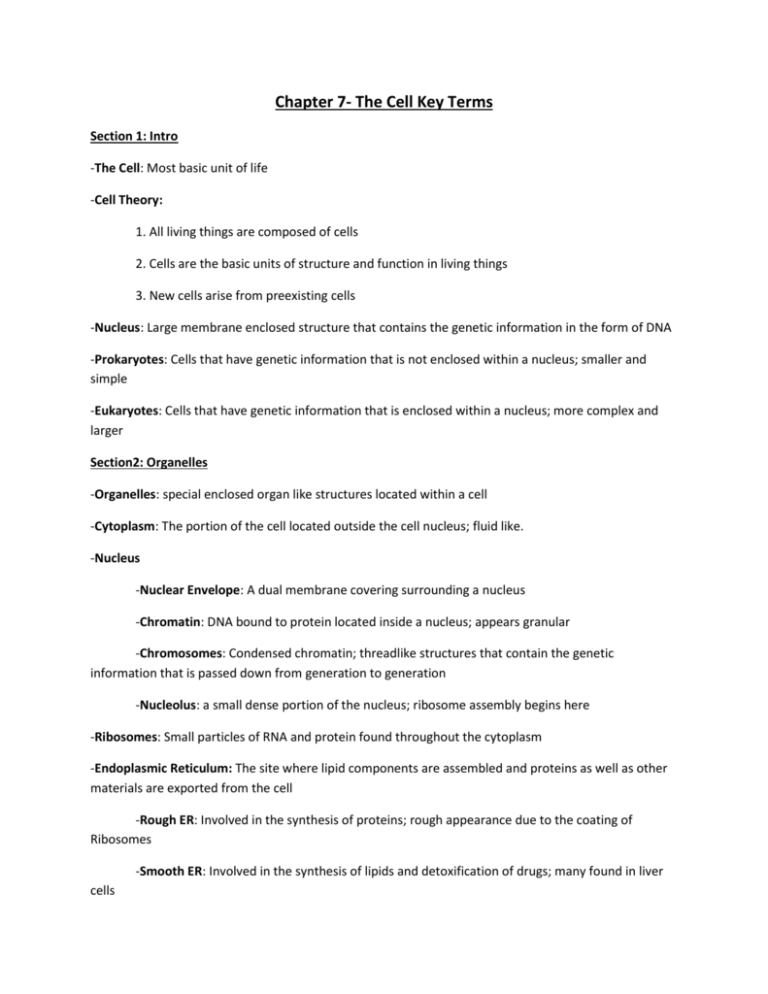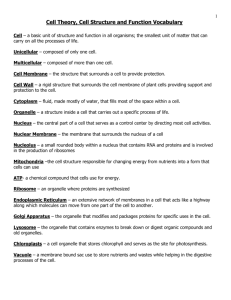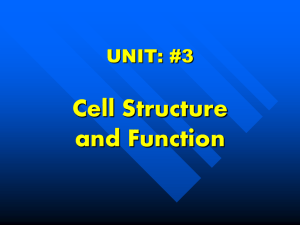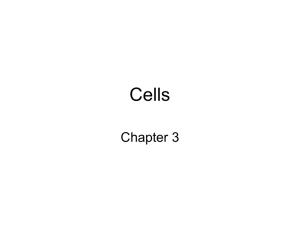Key Terms
advertisement

Chapter 7- The Cell Key Terms Section 1: Intro -The Cell: Most basic unit of life -Cell Theory: 1. All living things are composed of cells 2. Cells are the basic units of structure and function in living things 3. New cells arise from preexisting cells -Nucleus: Large membrane enclosed structure that contains the genetic information in the form of DNA -Prokaryotes: Cells that have genetic information that is not enclosed within a nucleus; smaller and simple -Eukaryotes: Cells that have genetic information that is enclosed within a nucleus; more complex and larger Section2: Organelles -Organelles: special enclosed organ like structures located within a cell -Cytoplasm: The portion of the cell located outside the cell nucleus; fluid like. -Nucleus -Nuclear Envelope: A dual membrane covering surrounding a nucleus -Chromatin: DNA bound to protein located inside a nucleus; appears granular -Chromosomes: Condensed chromatin; threadlike structures that contain the genetic information that is passed down from generation to generation -Nucleolus: a small dense portion of the nucleus; ribosome assembly begins here -Ribosomes: Small particles of RNA and protein found throughout the cytoplasm -Endoplasmic Reticulum: The site where lipid components are assembled and proteins as well as other materials are exported from the cell -Rough ER: Involved in the synthesis of proteins; rough appearance due to the coating of Ribosomes -Smooth ER: Involved in the synthesis of lipids and detoxification of drugs; many found in liver cells -Golgi Apparatus: Modify, sort, and package proteins and other materials from the ER and ships them out to other areas of the cell -Lysosomes: Small organelles filled with enzymes; used for breaking down or digestion of lipids, carbohydrates, and other proteins that could be used; it also breaks down organelles that have outlived their usefulness -Vacuoles: Sack like structures that contain and store water, salts, and proteins; much larger in plant cells than animal -Mitochondria: The powerhouse of the cell, convert chemical energy stored in food into compounds that are more convenient for the cell to use through cellular respiration -Chloroplasts: Found in plants, capture energy from the sun and convert it into chemical energy through photosynthesis -Cytoskeleton: A network of protein filaments that helps the cell to maintain its shape. The cytoskeleton is involved in movement as well. -Centrioles: located near the nucleus, and help to organize cell division -Microtubules: Hollow structures made up of tubulins (a form of protein used to hold a cells shape, forms the centrioles in animal cells during cell division. Also forms flagella or cilia that allow the cell to move or “swim” through water. -Microfilaments- Threadlike filaments made up of a protein called actin; forms a tough yet flexible framework that supports the cell. Section 3: Cell Boundaries -Cell Membrane: The thin flexible barrier that surrounds a cell. -Cell Wall: A strong, rigid supporting later around a cell membrane that helps the cell maintains its shape and structure. -Lipid Bilayer: What composes the cell membrane, a double lipid membrane with hydrophilic (water loving) heads facing the outside and inside of the cell, and hydrophobic (water fearing) tails between them -Concentration: The mass of a solute in a given volume of solution or mass/volume -Diffusion: Particles traveling from an area of high concentration to an area of low concentration and continues until it reaches equilibrium -Equilibrium: When the concentration of the solute is the same throughout a system -Osmosis: The diffusion of water through a selectively permeable membrane -Isotonic: The concentrations of both solutions are of the same strength; equilibrium -Hypertonic: The solute has a higher concentration than the cell; water will rush out of the cell and cause it to wither -Hypotonic: The solute has a lower concentration than the cell; water will rush into the cell and cause it to swell. -Facilitated Diffusion: Larger molecules, such as glucose, moving through a cell membrane with the help of a cell membrane protein. -Active Transport: The movement of materials against the concentration gradient (high to low and vice versa); this requires energy. -Molecular Transport: Small molecules and ions that are carried across membranes by proteins in the membrane that works similar to a “energy requiring pump”. The changing in protein shape play a considerable factor in this when determining how much energy is needed to pump an ion across. -Endocytosis: The process of taking material into a cell by means of the foldings or pockets of the cell membranes -Phagocytosis: When extensions of the cytoplasm surround a particle, package it into a food vacuole, then ingest it; also referred to as “Cell Eating” -Pinocytosis: When tiny pockets form along the cell membrane, fill with liquid, and pinch off to form vacuoles within the cell; also referred to as “Cell Drinking” -Exocytosis: When the membrane of vacuole fuses with the cell membrane forcing its contents out of the cell. Contractile vacuole (a type of pumping mechanism in some simple cells) removing water from the cell is an example of this. Section 4: Diversity of Cell Life -Unicellular Organism: An organism that is composed of a single cell -Multicellular Organism: An organism composed of many cells, and depends on the concept of cell specialization -Cell Specialization: Cells throughout an organism developing in different ways to perform specific and specialized tasks -Specialized Animal Cells Examples: Red Blood cells, Muscle cells, any cell that produces proteins of some sort -Specialized Plant Cells Examples: Stomata, Guard Cells -Levels of Organization: -Tissues: 1st level of organization; similar cells group together to perform a specific function; EX: Smooth Muscle Tissue -Organs: 2nd level of organization; many groups of tissues all working together to perform a specific function; EX: The Stomach -Organ Systems: 3rd Level of organization; a group of organs that work together to perform a specific function in the human body; EX: The Digestive System









